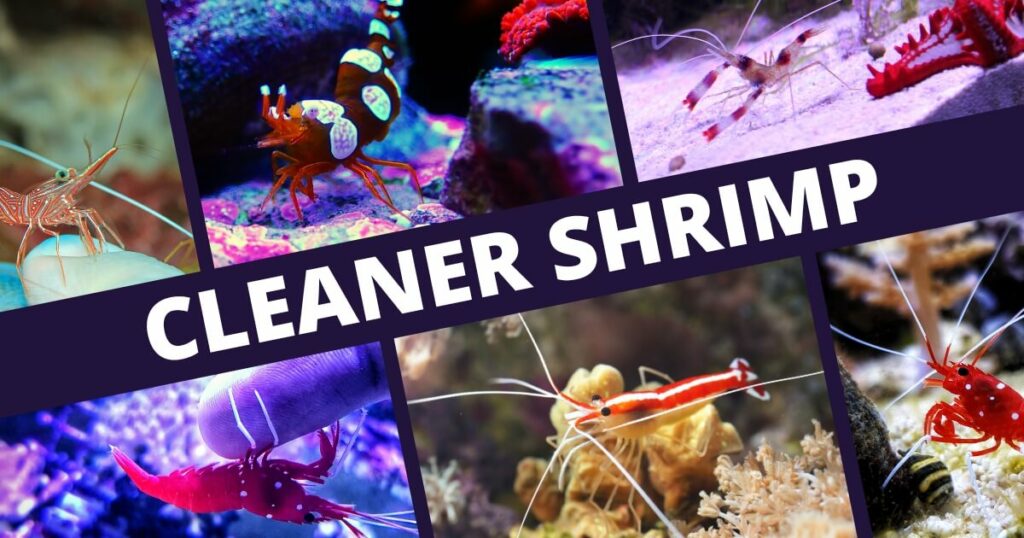Cleaner shrimp play a key role in maintaining the health of other marine inhabitants by cleaning them of parasites and dead skin. Their easy care level and peaceful nature make them a great choice for both novice and experienced reef keepers.
Quick Facts:
- Classification: Shrimp
- Care Difficulty: Easy to Moderate
- Diet: Carnivore
- Size: 2″ to 3″ (not including antennae)
- Temperament: Peaceful & Community-oriented
- Reef Compatibility: Excellent
- Tank Minimum: 20 gallons
- Lifespan: Up to 3 years in captivity
- Reproduction: Very difficult in captivity
- Types: Banded Coral Shrimp, Spotted Cleaner Shrimp, Scarlet Skunk Cleaner Shrimp, Blood Red Fire Shrimp, True Peppermint Shrimp

Care Guide & Information

Acclimation
Properly acclimating cleaner shrimp to your tank is crucial for minimizing stress and avoiding shock.
- Turn off your tank lights and float the sealed bag containing the shrimp in your aquarium to equalize the water temperature for about 15 minutes.
- Gradually introduce small amounts of tank water into the bag every 10 minutes over an hour to match water parameters.
- Gently net the shrimp out of the bag and release it into your tank, discarding the bag water to prevent contaminating your system.
Habitat Setup
Creating a habitat that mirrors their natural environment is vital for the well-being of cleaner shrimp.
They thrive in tanks with plenty of live rock and crevices for hiding and molting.
A sandy substrate combined with ample hiding spots offers a stress-free space for these invertebrates.
Maintaining stable water conditions—temperature, pH, and salinity within their preferred range—is essential for their health.
- Temperature: 74°F to 78°F
- pH: 8.1 to 8.4
- Salinity: 1.023 to 1.025 specific gravity
Diet & Feeding
Cleaner shrimp are not picky eaters, but ensuring they receive adequate nutrition can be challenging in a community tank setting where other inhabitants might outcompete them for food.
What do cleaner shrimp eat?
- Parasites and dead tissue from fish (their natural diet)
- Critters living on algae
- High-quality frozen foods such as brine shrimp and mysis shrimp
- Flake foods and pellets designed for marine species (occasionally)
- Small pieces of fish or seafood as occasional treats
- Some Peppermint Shrimp will prey on Aiptasia Anemones
Feeding them directly with tweezers can ensure they get their share, especially in the early days when they’re still shy.
Behavior & Tank Mates
Cleaner shrimp are peaceful inhabitants that get along with most reef-safe fish and invertebrates. Other tank mates often appreciate their cleaning services, although some larger or more aggressive species might see them as food rather than helpers.
They do not pose any threat to corals or other sessile invertebrates.
Health Monitoring
Healthy cleaner shrimp are active with clear eyes and vibrant colors. Signs of stress or illness include lethargy, lack of appetite, or faded colors. Molting is normal and indicates good health. However, you must ensure enough hiding spots to protect them during this vulnerable time.
Breeding
Breeding cleaner shrimp in home aquariums is extremely challenging but not impossible. A pair will often spawn after molting if conditions mimic their natural habitat closely. Stable water parameters and plenty of food are key factors here.
However, raising the larvae to adulthood requires specific setups that mimic planktonic stages in open water. These setups are complicated and expensive for average hobbyists.
Cleaner Shrimp Tips
Beyond the basics of care, a few nuggets of wisdom can elevate your experience with cleaner shrimp. These insights are born from the trials, errors, and successes of fellow hobbyists, including myself. Here’s what I’ve learned:
- Molting Preparation: Cleaner shrimp may hide more and eat less before molting. This is normal behavior as they prepare for the vulnerable phase of shedding their exoskeleton.
- Feeding Finesse: While they’re not picky eaters, offering a variety in their diet can enhance their coloration and activity level. Think of it as spicing up their life!
- Observation is Key: Regularly watching your cleaner shrimp provides enjoyment and allows you to catch any signs of stress or illness.
- Handling With Care: When necessary, be gentle in handling them. Their bodies are delicate, especially right after molting when their new exoskeleton hasn’t hardened yet.
Frequently Asked Questions
How often do cleaner shrimp molt?
Cleaner shrimp typically molt every 4-6 weeks, but this can vary depending on their growth rate and environmental conditions.
Do cleaner shrimp eat ich?
Yes, cleaner shrimp can help control ich (a common fish parasite) by eating the parasites off infected fish during their cleaning sessions. However, this should not be relied on for treatment of ich in your tank.
Do cleaner shrimp eat algae?
No, cleaner shrimp primarily feed on parasites and dead tissue from fish. They might occasionally pick at algae for the critters living on it but do not rely on it as a food source.
Why is my cleaner shrimp not eating?
If your cleaner shrimp isn’t eating, it could be due to stress from recent changes in the tank environment, or it might be preparing to molt. Ensuring stable conditions should help revive its appetite.
